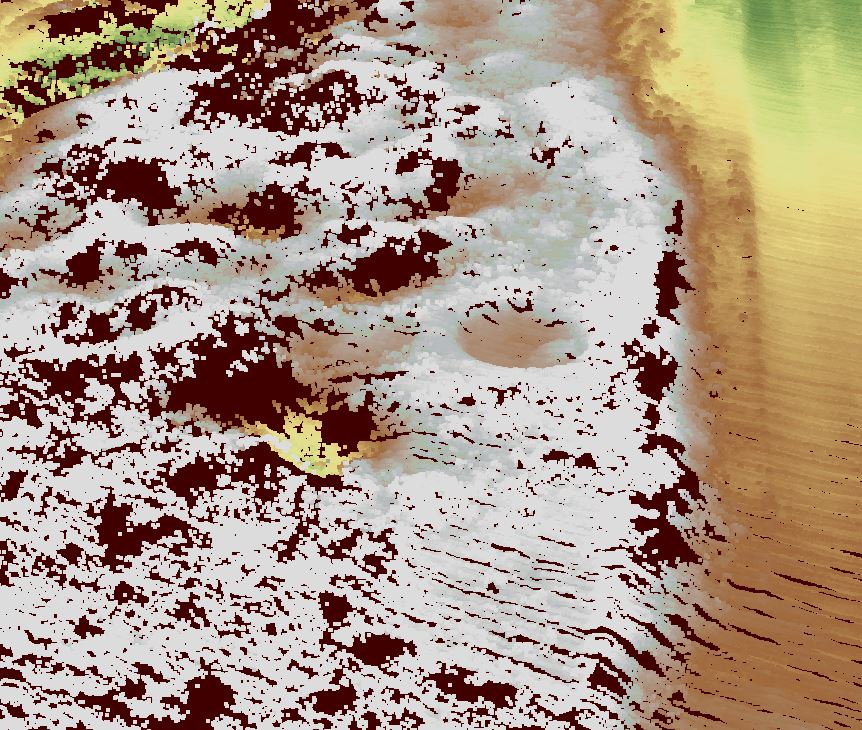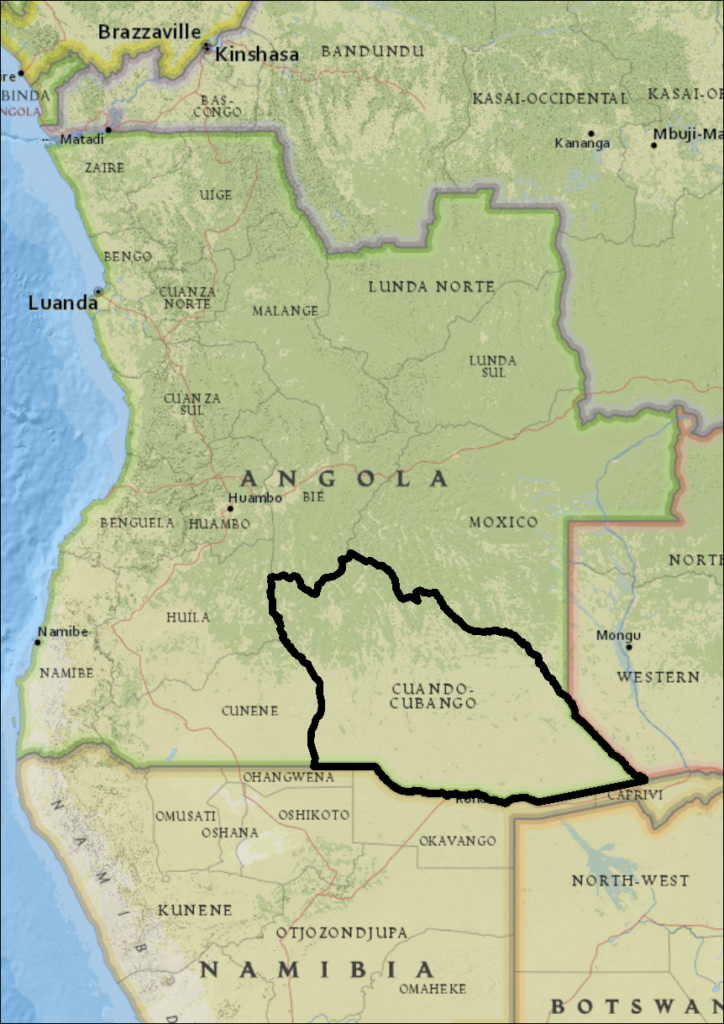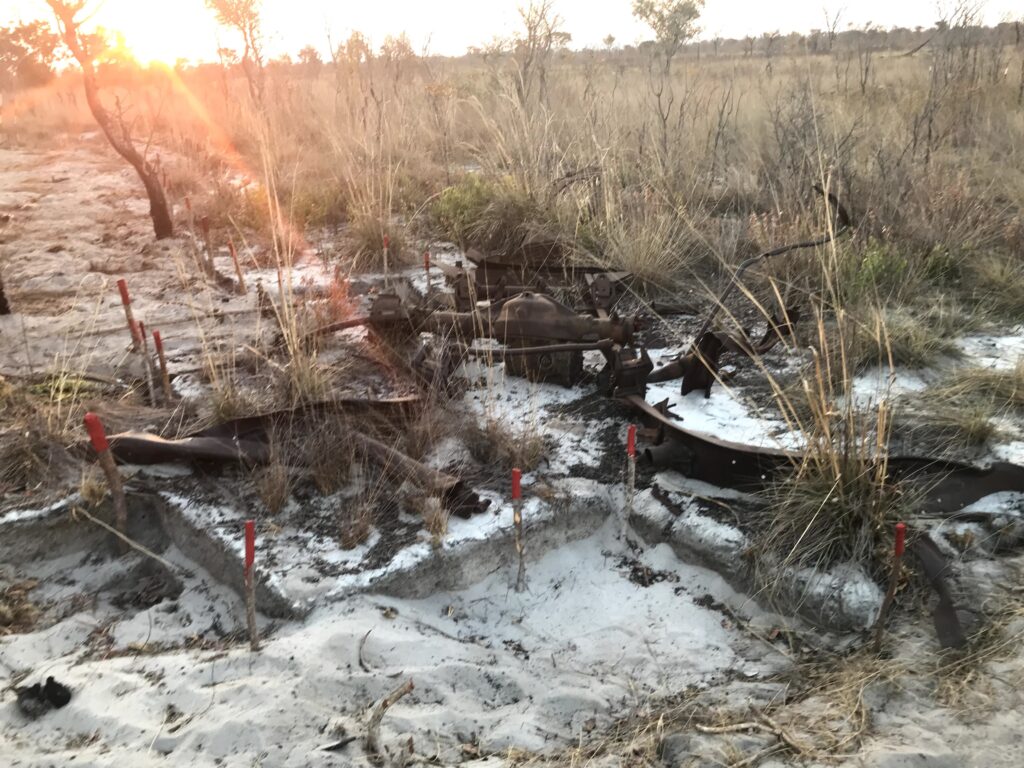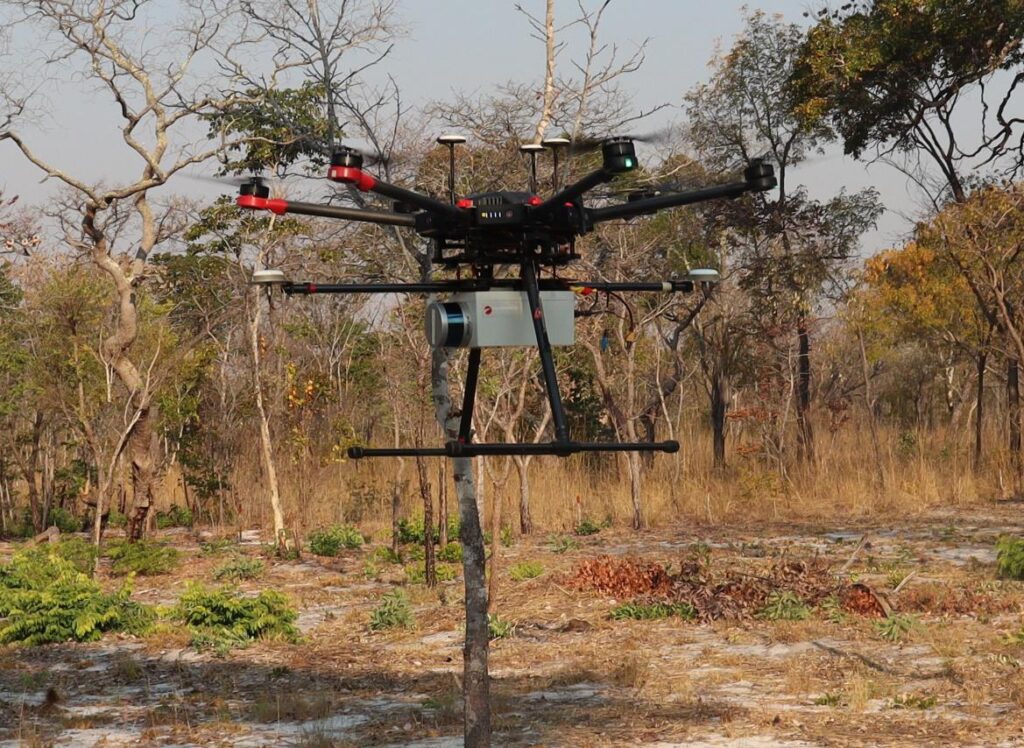Casualties from landmines and explosive remnants of war have been worryingly high for the past seven years. This trend is mainly the result of increased conflict and contamination by improvised mines observed since 2015. Lamentably, most of the victims recorded were civilians and half of these were children.
As efforts continue to clear mine-contaminated land, much remains to be done. The HALO Trust, a British mine-clearance charity, has been trialling drone remote sensing, including thermal infrared (TIR) and RGB cameras, to support the identification of unexploded ordnance (UXO) in Angola. Unfortunately, many contaminated sites are overgrown with vegetation: thus the UXO and features of conflict, such as trenches, bunkers or craters which suggest the presence of UXO, are no longer visible from the ground or the air using UAV-mounted RGB or TIR sensors.
The HALO Trust partnered with Routescene, an established UAV-lidar system and software supplier, to demonstrate the benefits of UAV-lidar to detect and map minefield features to inform clearance planning. UAV-lidar’s ability to penetrate vegetation enabled the survey team to map trench extents, bunkers and craters to predict where a mine line may be located (Figure 1). The results made clearance efforts safer and expedited a targeted approach to them.
The project was undertaken over three years, starting with a feasibility study in Scotland in 2020 before moving to Angola in 2021. To the authors’ knowledge, this is the first time that UAV-lidar has been used to identify battlefield features in Angola to aid clearance efforts.
Feasibility study in Scotland in 2020
Routescene and The HALO Trust are both headquartered in Scotland and the teams performed a test drone survey locally by simulating a mine crater at a suitably vegetated site. The UAV-lidar data captured was post-processed using LidarViewer Pro, Routescene’s proprietary lidar-processing software. The replica mine crater was easily identified in the digital terrain model (DTM) created (Figure 2) validating that UAV-lidar would be capable of locating and mapping battlefield remains in Angola.
UAV surveys in Angola
Three sites in Cuito Cuanavale, in the province of Cuando Cubango, Angola (Figure 3) were specifically chosen for the project as each had known or suspected battlefield features, of which main trenches, communication trenches, foxholes (one-man defensive positions), shell scrapes (shallow excavations allowing soldiers to shield from shell bursts and small arms fire) and craters from detonations were expected to be detected.The Angolan civil war was fought from 1975 until 2002 and Cuando Cubango experienced some of the heaviest fighting. The Battle of Cuito Cuanavale was the largest conflict of the war.
Throughout the conflict there was extensive mine-laying by both sides. Many of the minefield sites are 20-30 km, long including mixed threat mine belts of Anti-Vehicle (AV) and Anti-Personnel (AP) mines, which still pose a deadly threat to the local community (Figure 4).
Data collection
The terrain across the three chosen sites was similar in terms of elevation, all being relatively flat, however the degree of vegetation coverage varied considerably: Sites A and C had dense tree coverage whereas Site B had light tree and shrub coverage.At Sites A and B lidar data was collected from 40 m above ground level (AGL) with one day of collection for each site. At Site C data was collected at 50 m AGL over three days. Due to the size of the area and time limitations the data was collected at a higher altitude than at Sites A and B.Sites A and B were surveyed during the dry season (August 2021) when vegetation cover was at its lowest. Site C was surveyed during the rainy season (April 2022) when vegetation cover was at its highest.Due to a lack of safe access only a partial UAV-lidar survey was completed at Site A.
Equipment and software
Routescene constructed a demonstration UAV Lidar System for this project containing a 16 channel Lidar sensor, capable of collecting approximately 600,000 points per second, a GNSS/INS sensor and data storage to capture 12 hours of data. Designed to be resistant to vibrations in flight and handling by users, the system does not require mobile or internet connection to operate, providing operational autonomy and data security. GNSS data was collected for the post processing of the trajectory to ensure the data was as accurate as possible.The UAV Lidar System was mounted onto a hexacopter capable of lifting a 5kg payload for approximately 15 minutes (Figure 5).
The raw lidar datasets were processed using Routescene’s LidarViewer Pro software to create and export DTMs from each of the sites for analysis in ArcGIS Pro. In areas where there were large gaps in the mine lines or a sharp change in direction, the UAV-lidar data was analysed to identify the locations of craters from mine detonations, often caused by animal accidents and wildfires, to inform the location of the mine line.
Site A results
Site A was an abandoned military base outside of Longa village, 100 km northwest of Cuito Cuanavale. Satellite imagery showed little evidence of the historical military base: an access path was visible but it was not possible to identify other features. When it was overlaid with the UAV-lidar data, however, multiple features became apparent (Figure 6):
- The defensive main trench around the former base was the predominant feature and 496 m of main trench was identified.
- A communications trench branching off the northwestern internal side of the main trench and 40 m of communication trenches were identified.
- 10 foxholes follow the inside of the main trench dug as defensive positions.
- 9 crater-like features clustered inside the base with two further north near the communications trench which are suspected shell scrapes.
- A line of 6 crater-like features outside the main trench, which are unlikely to be AV mines as none were found at this location, so these may be shell scrapes.
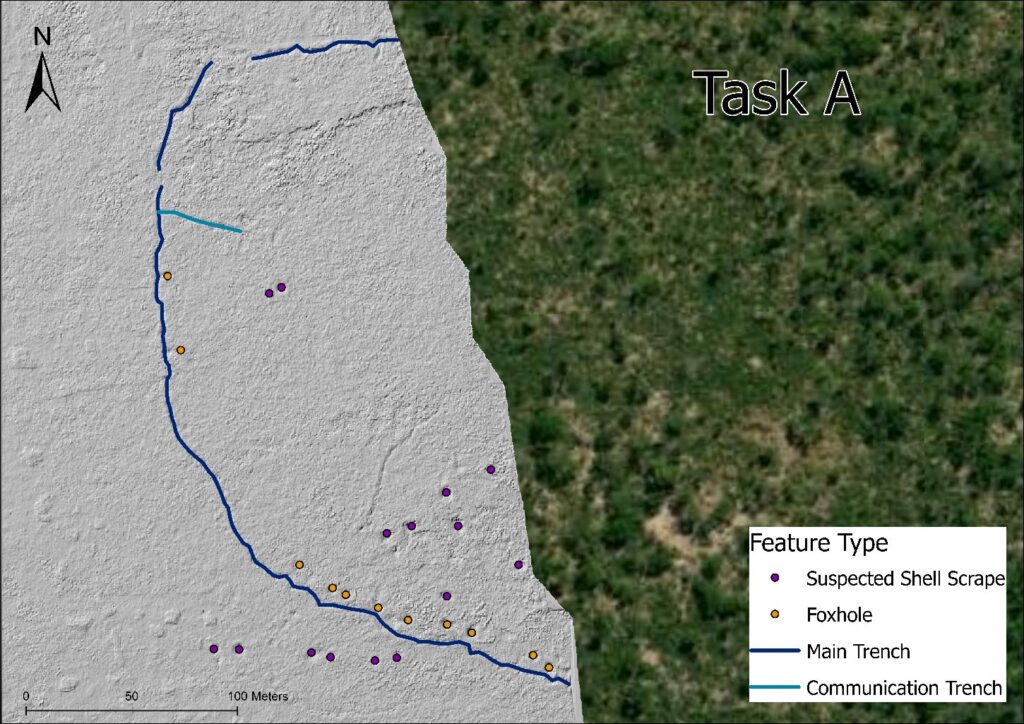
Figure 6: DTM showing the predominant battlefield feature types at Site A. Sources: Esri, DigitalGlobe, GeoEye, i-cubed, USDA Farm Service Agency, USGS, AEX, Getmapping, Aerogrid, IGN, IGP, swisstopo, and the GIS User Community.
The average depth and width of the foxholes (0.58 m and 2.36 m respectively) and the suspected shell scrapes (0.77 m and 2.38 m respectively) were similar, suggesting that these are the same feature. However, due to the suspected shell scrapes not being in the typical location and pattern of foxholes, they were identified as a separate feature.Where accessibility and vegetation coverage allowed, the feature types were confirmed with a ground mission.
Site B results
Site B was an extensive defensive mine line with an associated trench, 9 km east of Cuito Cuanavale. Due to the lighter vegetation coverage at Site B, there was slight evidence of the main trench remains in the satellite imagery and tracks were clear to see, though other features were not visible. Again, when the UAV-lidar data was overlaid, analysis identified multiple features (Figure 7):
- A larger extent of the main trench, in total 500 m.
- 281 m of communication trenches.
- 34 foxholes, which averaged 0.67 m in depth and 2.54 m in width.
- 2 suspected craters, which averaged 5.85 m in width and 0.65 m in depth. Possibly from exploded ordnance but unlikely to be from AV mines, these features were in an uncleared area, so it was not possible to confirm their exact nature.
- The UAV-lidar data revealed additional historical tracks and this information was used to identify locations of possible safe access roads to the site.
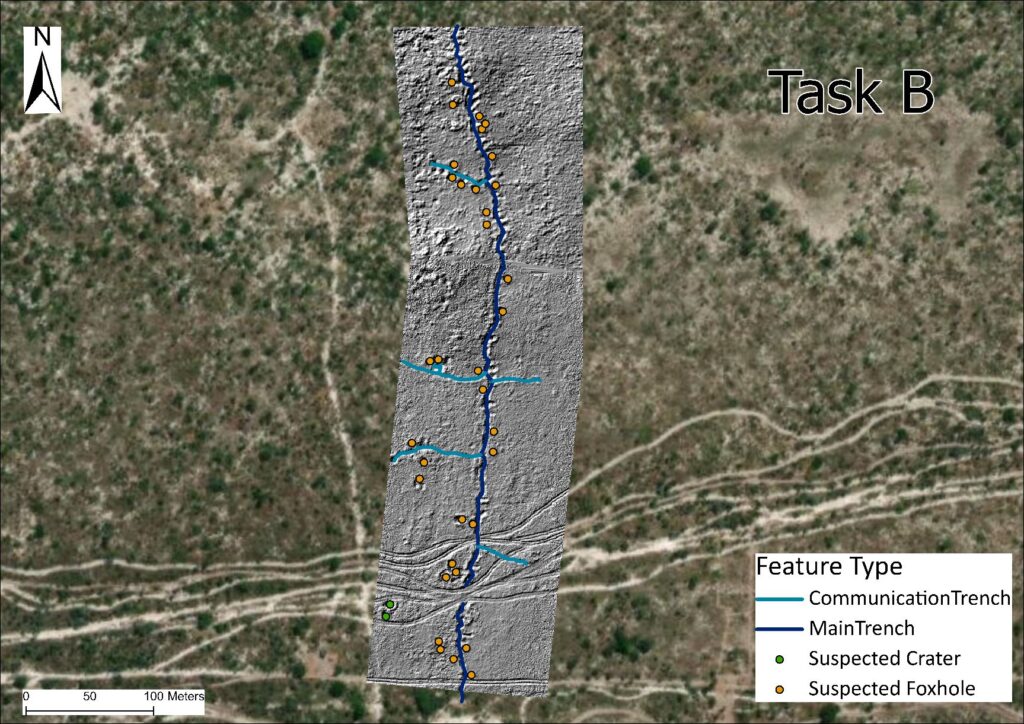
Figure 7: DTM showing the predominant battlefield feature types at Site B. Sources: Esri, DigitalGlobe, GeoEye, i-cubed, USDA Farm Service Agency, USGS, AEX, Getmapping, Aerogrid, IGN, IGP, swisstopo, and the GIS User Community.
Due to thick vegetation and lack of safe access at this site, it was difficult to see what remained of the trench system during field visits.
Site C results
Site C, an abandoned military base, 25 km southeast of Cuito Cuanavale, showed evidence of AP mine laying within the previous military base and was suspected to have at least a single trench and multiple foxholes. From satellite imagery and from the ground it was not possible to identify the locations of the suspected battlefield features due to the dense vegetation. The UAV-lidar data showed evidence of (Figure 8):
- 2 trench systems surrounding the former base as well as communication trenches.
- 157 crater-like features which follow both trench lines, believed to be foxholes due to their regular spacing in close proximity to the trench lines.
The data highlighted gaps in the trench systems which could be explained by the infill of soil over time levelling out the ground within the trench or rainwater lying in the trench preventing the Lidar pulses from reaching the bottom.

Figure 8: DTM showing the predominant battlefield feature types at Site C. Sources: Esri, DigitalGlobe, GeoEye, i-cubed, USDA Farm Service Agency, USGS, AEX, Getmapping, Aerogrid, IGN, IGP, swisstopo, and the GIS User Community.
Although the trench data was incomplete, the continuation of foxholes between the two extents of the inner trench suggests that the trench once continued to create a circular inner trench system. Overall, 1429 m of main trench (828 m on the outer trench and 601 m of inner trench), 73 m of communication trench and 157 foxholes were identified at this site. The foxholes averaged 0.80 m in depth and 2.81 m in width.
The outcome
This pioneering work demonstrated that UAV-lidar data provides evidence that is not obtainable by other means, particularly when looking for battlefield features hidden by vegetation. The analysis of the DTMs created from the UAV-lidar data yielded evidence of trenches, craters and foxholes at all the sites surveyed: features which were either not detectable or only partially visible in satellite imagery, UAV RGB and TIR imagery or from the ground. This evidence was used to create targeted clearance plans, making clearance efforts safer and quicker.Remote sensing is complementary to conventional minefield survey techniques. Within The HALO Trust’s mine clearance operations in Angola, the UAV-lidar data outputs, combined with contextual knowledge on the ground, provided valuable information to supplement conventional survey operations and to target future surveys and clearance operations.
Acknowledgements from The HALO Trust
Thanks to an anonymous private donor for their extremely generous support for the UAV trials in Angola and their commitment to innovation in mine action, this project would not have been possible without their help; to Routescene for providing the UAV-lkidar system, software, training and ongoing support since 2020; to Claire Lovelace and Siân McGee from The HALO Trust Angola program for their ongoing support in the field and during data analysis.
References
Anon, 2022. Landmine Monitor 2022: major findings, Landmine & Cluster Munition Monitor, http://www.the-monitor.org/en-gb/reports/2022/landmine-monitor-2022/major-findings.aspx
Fardoulis, J., X. Depreytere and J. Guthrie, 2022. Proof: how TIR imaging can locate buried cluster munitions in the Iraqi desert, The Journal of Conventional Weapons Destruction, 25(3).
Fardoulis, J., X. Depreytere, P. Gallien, K. Djouri, B. Abourahmane and E. Sauvage, 2020. Proof: how small drones can find buried landmines in the desert using airborne IR thermography, The Journal of Conventional Weapons Destruction, 24(2).
Mills, G. and D. Williams, 2010. 7 Battles that Shaped South Africa, 2nd edition, Tafelberg, Cape Town, 208 pp.
Pearce, J., 2012. Control, politics and identity in the Angolan Civil War, African Affairs, 111(444): 442-465.
Shaughnessy, D., 2001. Some thoughts about Private Harold L. Green of the Scout Platoon, First Battalion, the Royal Hamilton Light Infantry, Canadian Military History, 10(1): 67-77.
 Gert Riemersma is chief technical officer at Routescene. He is a technical innovator, a land and hydrographic surveyor and Routescene’s founder. He has worked with lidar since 2008 and with UAV-lidar since 2013. Gert specializes in the development of 3D mapping systems and software, converting technically challenging problems into practical products.
Gert Riemersma is chief technical officer at Routescene. He is a technical innovator, a land and hydrographic surveyor and Routescene’s founder. He has worked with lidar since 2008 and with UAV-lidar since 2013. Gert specializes in the development of 3D mapping systems and software, converting technically challenging problems into practical products.
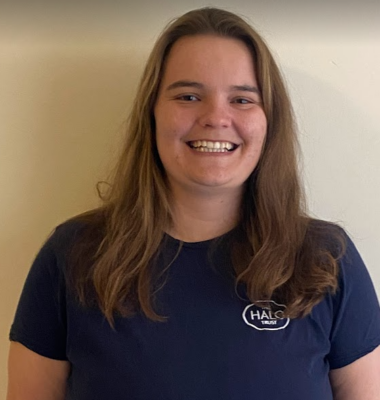 Katherine James, a remote sensing specialist with the HALO Trust, specializes in using UAVs to assist in the removal of landmines and other unexploded ordnance in countries and territories affected by conflict. She is also responsible for implementing the deployment of small drones for supporting non-technical surveys.
Katherine James, a remote sensing specialist with the HALO Trust, specializes in using UAVs to assist in the removal of landmines and other unexploded ordnance in countries and territories affected by conflict. She is also responsible for implementing the deployment of small drones for supporting non-technical surveys.
Pedro Pacheco is a GIS officer and drone pilot with the HALO Trust.

